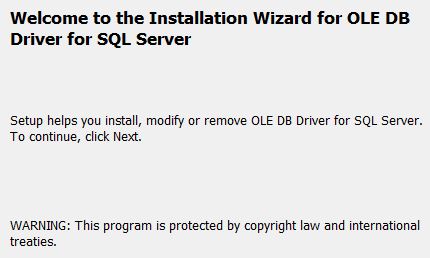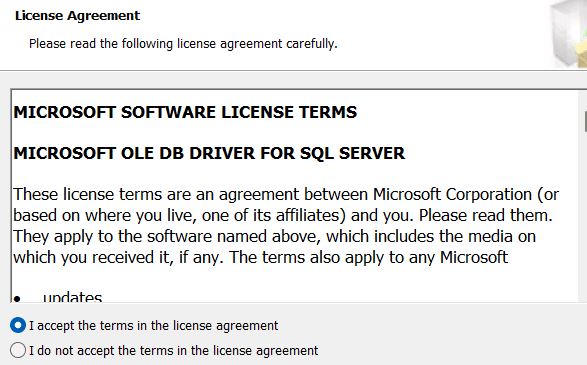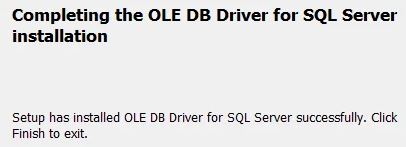Discover everything about the Microsoft OLE DB Driver for SQL Server in this comprehensive guide. Learn its history, advantages, installation steps, and joint issues.
The Microsoft OLE DB Driver for SQL Server is essential to database connectivity, providing a stable interface for data access across different SQL Server versions. Its features, background, installation procedure, frequent problems, and much more are covered in detail in this guide.
Table of Contents
Introduction
Applications may communicate with SQL Server databases more easily thanks to the high-performance data access component known as the Microsoft OLE DB Driver for SQL Server. As a result of its various features, which include complicated queries, high availability, and disaster recovery, it is a vital tool for database managers and developers.
A Glimpse into History
Microsoft unveiled OLE DB (Object Linking and Embedding Database) in the late 1990s as a Universal Data Access plan component. It was first created to access many kinds of data. Still, as it evolved through several iterations over the years, it became more focused on optimizing efficiency and capabilities for SQL Server.
Advantages
A few benefits of Microsoft OLE DB Driver are given below for more clarity & better understanding
Because of its many benefits, the Microsoft OLE DB Driver for SQL Server is recommended for database connectivity in various applications. The main advantages are as follows:
Excellent Work
Specifically created and optimized for SQL Server, the driver offers adequate data access and manipulation, resulting in quicker query execution and data retrieval.
Improved Interoperability
Supports Newest SQL Server Features: It is entirely compatible with the most recent features added to SQL Server so that programs can use the newest disaster recovery options and high availability.
Backward Compatibility: The driver keeps SQL Server versions older and compatible, enabling easy interaction with current systems.
Dependability and Steadiness
Sturdy Data Access: The driver offers a safe and dependable data access interface, ensuring that programs function correctly even in high traffic or intricate queries.
Error Handling and Diagnostics: Robust error handling and diagnostic features facilitate prompt problem identification and resolution, augmenting system dependability.
Adaptability
Multiple Development Environments: The driver allows developers to work with their favourite tools in various development environments, including Visual Studio.
Support for Various Data Types: It offers flexibility in managing various data operations by supporting a broad range of SQL Server data types.
Safety in Microsoft OLE DB Driver for SQL Server
Integrated Security: By enabling integrated Windows authentication, the driver offers a safe way to connect to SQL Server without requiring the transmission or storage of passwords.
Support for Encryption: It can support encryption protocols, which guarantee the security of data transferred between the application and the database.
Enhanced Output
Usability: The driver’s easy-to-configure and-use design minimizes the time and effort required to manage data operations and establish database connections.
Extensive Documentation: Developers and administrators can troubleshoot and optimize driver use more easily since Microsoft offers many documentation and support resources.
Superior Functionalities
Batch Processing: By lowering the number of round trips made by the application and database, batch processing of SQL queries can enhance performance.
Streaming Capabilities: massive items (LOBs) like pictures, films, and enormous text files can be streamed effectively thanks to the driver.
Combining Microsoft Technologies with Other Integrations
Seamless Integration: The OLE DB Driver creates a coherent ecosystem for data management and analytics by integrating with other Microsoft technologies and products, including SQL Server Reporting Services (SSRS), SQL Server Integration Services (SSIS), and SQL Server Analysis Services (SSAS).
Assistance with Disaster Recovery and High Availability
The driver supports SQL Server Always On Availability Groups, which offers high availability and disaster recovery options to guarantee constant data access.
Automatic Failover: The driver can minimize downtime by automatically rerouting connections to a secondary server in case of a server failure.
Support and Community for Microsoft OLE DB Driver for SQL Server
Microsoft Support: Access to Microsoft’s support channels guarantees that consumers can receive assistance from Microsoft engineers for any problems they may face.
Active Community: Since many developers and database administrators use the driver, there are documented solutions for many common issues, and community forums can be a great source of information.
Disadvantages
Although the Microsoft OLE DB Driver for SQL Server has many benefits, users should also be aware of its drawbacks. These are the main disadvantages:
Configuration Complexity
Configuration and Setup: Setting up and configuring the OLE DB Driver might be challenging for users unfamiliar with database drivers and connectivity settings. A high learning curve may be necessary to ensure proper configuration, which is essential for optimal performance and security.
Extensive Use of Resources
High Resource Consumption: In situations with a lot of stress on the system, the driver can be resource-demanding. If the server or system is not sufficiently equipped with CPU, memory, and storage resources, this may result in performance problems.
Platform Independency
Windows-Centric Design: The OLE DB Driver for SQL Server’s main target audience is Windows operating systems. Though it can be used on other platforms using virtual machines or compatibility layers, it does not natively support non-Windows environments.
The Risk of Disintegration
Multiple Versions: Fragmentation may result from different versions of OLE DB and other database drivers (like ODBC and JDBC). Developers and administrators may need to manage and support various driver versions, which can make maintenance and support tasks more difficult.
Limited Support Across Platforms
Compatibility Issues: The OLE DB Driver works well with SQL Server but can be challenging to use in cross-platform situations or with databases that are not Microsoft products. Alternative drivers or data access technologies might be more appropriate in certain situations.
Reliance on Versions of SQL Server
Version Compatibility: While the driver supports several SQL Server versions, it’s possible that earlier versions of the driver don’t completely support new features or optimizations added in later SQL Server versions. This can be logistically challenging because it requires maintaining the most recent versions of both the driver and SQL Server.
Overheads for Performance
Possible Overheads: Compared to other data access techniques, the OLE DB Driver may have performance overheads. This is especially true if the driver is used in settings that do not fully utilize its advanced features or if it needs to be tuned correctly.
Limited Community Knowledge
Requires More specific expertise: Compared to more widely used database drivers like ODBC, the OLE DB Driver for SQL Server may require more specific expertise, even though there is a user community. Obtaining knowledge and assistance can occasionally take more work.
Migration Difficulties of Microsoft OLE DB Driver for SQL Server
Moving from Other Drivers: Switching to OLE DB from other data access technologies (like ODBC or JDBC) can be difficult. Testing and considerable code changes could be necessary to assure compatibility and performance.
Incoherent Documentation and Assistance
Uncoordinated Documentation: Despite Microsoft’s extensive documentation, some users need clarification. This can make learning and troubleshooting more difficult, particularly for inexperienced users.
Security Issues with Microsoft OLE DB Driver for SQL Server
Configuration Vulnerabilities: If improperly configured, the Microsoft OLE DB Driver for SQL Server may reveal security flaws.
Different Generations of OLE DB Drivers
Over time, the requirements for database connectivity and data access have changed and grown, and as a result, the OLE DB (Object Linking and Embedding Database) drivers have changed as well. The features and variations of the various OLE DB driver generations for SQL Server are listed below:
SQL Server OLE DB Provider (SQLOLEDB)
Introduction: As part of Microsoft’s Universal Data Access (UDA) plan, this is the first generation of OLE DB providers for SQL Server.
Qualities:
basic assistance with data access from SQL Server.
included Microsoft Data Access Components (MDAC) functionality.
provided a means for different applications to connect to SQL Server databases and supported the fundamental features of SQL Server.
Restrictions:
smaller feature set than in most recent iterations.
There were not many performance enhancements.
Native Client for SQL Server (SNAC)
Presented with SQL Server 2005, this feature combines OLE DB and ODBC features into a single native client.
Features:
Improved efficiency and assistance with novel SQL Server functionalities.
supported several SQL Server versions starting with SQL Server 2005.
Support for features unique to SQL Server, such as XML data types, User-Defined Types (UDTs), and Multiple Active Result Sets (MARS), was included.
Restrictions:
When used as a unified client, SNAC complicated applications that simply required ODBC or OLE DB features.
Development and support came to an end when Microsoft moved to newer technologies.
Microsoft OLE DB Driver (MSOLEDBSQL) for SQL Server
Introduction: Designed to handle new SQL Server features and provide ongoing support for OLE DB, this client was first announced in 2017 as a replacement for the outdated SQL Server Native Client.
Qualities
high-speed data connectivity with improved dependability and security.
Complete support for SQL Server 2012, including SQL Server 2022, up to the most recent versions.
support for new data types, Always On availability groups, and other contemporary SQL Server capabilities.
Microsoft releases updates on a regular basis to provide security improvements and new features for SQL Server.
Restrictions
Reduced development and deployment complexity by concentrating just on OLE DB.
Future SQL Server release compatibility is guaranteed by ongoing support and updates.
enhanced feature set and performance over earlier generations.
Upcoming Improvements and Developments
Constant Updates: To guarantee that the OLE DB Driver for SQL Server supports the most recent features and upholds strict performance and security guidelines, Microsoft has promised to update it frequently.
Prioritize Security and Performance: Upcoming versions are anticipated to concentrate on improving security features, optimizing performance, and integrating with developing SQL Server functionality.
An Overview of the Generations
SQL Server OLE DB Provider (SQLOLEDB): The original provider with few features.
SQL Server Native Client (SNAC): Improved speed, feature support, and combined OLE DB and ODBC functionality are all offered by the SQL Server Native Client (SNAC).
Microsoft OLE DB Driver for SQL Server (MSOLEDBSQL): The Microsoft OLE DB Driver for SQL Server (MSOLEDBSQL) is a state-of-the-art driver that prioritizes security, high performance, and compatibility with the most recent SQL Server capabilities.
Pre-requisites to Install Microsoft OLE DB Driver for SQL Server
Operating System: Windows 8, Windows Server 2012, or later.
SQL Server: SQL Server 2012 or later.
.NET Framework: .NET Framework 4.6 or higher.
Administrative Privileges: Required for installation.
How to Install Microsoft OLE DB Driver for SQL Server
Download: Obtain the driver from the official Microsoft Download Center.
Run Installer: Launch the downloaded executable file.

Product License Agreement: Read and agree to the terms stated in the product’s license agreement.

Select Installation Path: Choose the default or specify a custom path.

Finish Installation: To finish the installation procedure, adhere to the prompts.

Verify Installation: Check the installation through the ODBC Data Source Administrator.
Common Issues with Microsoft OLE DB Driver for SQL Server and Possible Solutions:
There are occasions when using the Microsoft OLE DB Driver for SQL Server can result in joint problems that could impair the functionality, performance, and connection of databases. The following are some of the most typical issues and their fixes:
Errors in Connection
Problem:
Failed to establish a connection to the SQL Server database; errors included “Cannot generate SSPI context” and “Login failed for user.”
Resolution:
Check the Connection String: Make sure the server name, database name, user ID, and password are included in the connection string and that it is accurate.
Verify Network Connectivity: The SQL Server must be able to be accessed by the client computer via the network. Ping the server to ensure that the required ports (by default, 1433) are open.
Configuration of SQL Server: Ensure that remote connections are enabled in SQL Server. To check the TCP/IP protocol settings, use the SQL Server Configuration Manager.
Verify that the SQL Server is configured in the appropriate authentication mode (either Windows Authentication or SQL Server Authentication).
Unable to locate the Microsoft OLE DB Driver for SQL Server
Problem:
Errors are saying that there is a problem installing or locating the OLE DB Driver for SQL Server.
Resolution:
Put the Driver in Place: The most recent OLE DB Driver for the SQL Server version can be downloaded and installed from the Microsoft Download Center.
Check Install Path: Make sure the driver is installed in the correct directory and, if necessary, add the path to the system’s environment variables.
Problems with Performance
Problem:
Slow query performance or sluggish application while utilizing SQL Server’s OLE DB Driver.
Resolution:
Optimize Queries: To cut down on execution time, review and improve SQL queries. Use query optimization and indexing strategies.
Update Statistics: UPDATE STATISTICS on pertinent tables to make sure database statistics are current.
Resource Allocation: Verify that there are no bottlenecks by checking the server’s resources (CPU, RAM, and disk I/O). As needed, modify the distribution of resources.
Reduce the overhead of creating new connections by utilizing connection pooling.
Issues with Compatibility
Problem:
Incompatibility between OLE DB Driver and SQL Server versions.
Resolution:
Updates for Drivers: Make sure the Microsoft OLE DB Driver for SQL Server is the most recent version that works with the SQL Server version you are running. Microsoft changes its drivers on a regular basis to ensure compatibility.
SQL Server Updates: Make sure your SQL Server instance has the most recent service packs and fixes installed.
Security Concerns
Problem:
Vulnerabilities brought about by improper security setups, like connections that aren’t encrypted.
Resolution:
Enable Encryption: Set up the driver and SQL Server so that data is transmitted using SSL/TLS encryption. Setting the proper connection string arguments will accomplish this.
Employ Integrated Security: To prevent sending user credentials in the connection string, whenever possible, utilize Windows Authentication.
Conduct routine security audits to make sure security best practices are being followed.
Mismatches in Data Types
Problem:
Data corruption or errors as a result of SQL Server and application data formats not matching.
Resolution:
Data Type Mapping: Make sure that application variables and SQL Server fields have the correct data types mapped. Transform data types as needed.
Employ parameterized queries to enhance security by thwarting SQL injection attempts and steer clear of problems caused by data type inconsistencies.
Issues with Transaction Management
Problem:
Problems with transaction management, like protracted transactions or deadlocks.
Resolution:
Deadlock Resolution: Retry logic should be implemented for transactions that get stuck. Examine deadlock graphs to determine and address the underlying reason.
Transaction Scope: To lower the chance of blocking and locking problems, keep transactions as brief as feasible.
Isolation Levels: To strike a balance between concurrency and consistency, select the proper transaction isolation level.
Leaks in Memory
Problem:
Microsoft OLE DB Driver for SQL Server memory leaks, which eventually result in higher memory utilization.
Resolution:
Resource cleanup: After using any resource, make sure that it is closed appropriately and disposed of, including connections, commands, and readers.
Monitoring Tools: To identify and address memory leaks in the program, use memory profiling and monitoring tools.
Problems with Installation
Problem:
Difficulties with permissions or missing dependencies that arise during installation.
Resolution:
Administrator Rights: To guarantee that every component is installed correctly, run the installer with administrator rights.
Verify Dependencies: Before installing the driver, make sure all necessary dependencies—such as particular.NET Framework versions—are installed.
Handling Errors and Diagnostics
Problem:
Insufficient error handling and troubleshooting diagnostic data.
Resolution:
Turn on Logging: To record error messages and diagnostic data, turn on comprehensive logging in your program.
Employ Try-Catch Blocks: Try-catch blocks can be used to implement complete error management, handling errors gently and generating informative error messages.
FAQs
Q: Microsoft OLE DB Driver for SQL Server: What is it?
Ans: A collection of COM-based interfaces for accessing various kinds of data is called OLE DB.
Q: How can I download the Microsoft OLE DB Driver for SQL Server?
Ans: Utilize the Microsoft Download Center to obtain it.
Q: Do Microsoft OLE DB Driver for SQL Server drivers come free?
Ans: Yes, Microsoft makes it available for free.
Q: Which OSs are compatible with the Microsoft OLE DB Driver for SQL Server?
Ans: Windows Server 2012, Windows 8 and later iterations.
Q: Can non-Microsoft databases be used with the OLE DB driver?
Ans: Although it is designed with SQL Server in mind, other databases could need alternative suppliers.
Q: Which Microsoft OLE DB Driver for SQL Server version is the most recent?
Ans: To find the most recent version, visit the Microsoft website.
Q: Does installing the driver require administrator privileges?
Ans: Indeed, the need for administrative privileges exists.
Q: How many connection failures can be fixed?
Ans: Check the network connectivity, server name, and authentication information.
Q: Is it possible to install an OLE DB driver on a server?
Ans: It is possible to install it on client computers as well as servers.
Q: Are OLE DB and ODBC different from one another?
Ans: Yes, both C-based ODBC and COM-based OLE DB are used for data access.
Conclusion
The Microsoft OLE DB Driver for SQL Server offers many advantages, making it an excellent option for applications that need strong database access to SQL Server. These advantages include high performance, compatibility, dependability, security, and customization. Its sophisticated features and smooth connection with other Microsoft technologies further increase its significance for developers and administrators.
These include possible performance overheads, high resource consumption, restricted cross-platform compatibility, and complicated configuration. Users must make sure they have the knowledge and tools needed to handle the driver successfully, as well as give serious thought to these drawbacks.
Review the below articles also
Dbcc Freeproccache: A powerful command
PAGEIOLATCH_SH: Unveiling the Secrets
Postgresql vs SQL Server:A Powerful DBMS
Discover Polybase: Top 7 Usage
Unlocking the Power of DBCC USEROPTIONS in SQL Server
SQL Server 2019: Powerful RDBMS


I like this website. It’s a master piece! Glad, I discovered this.
Thanks
Ewan Eklund